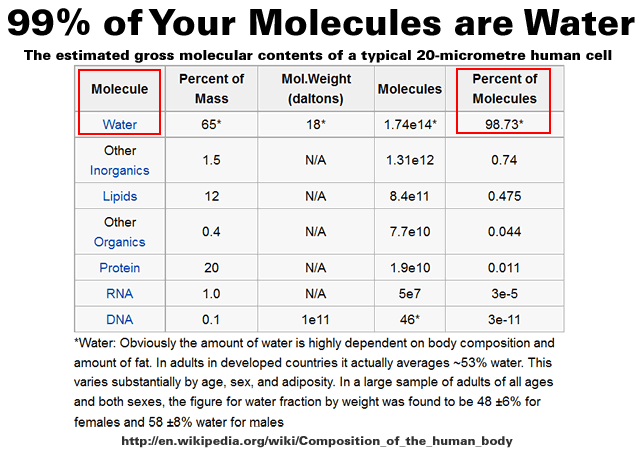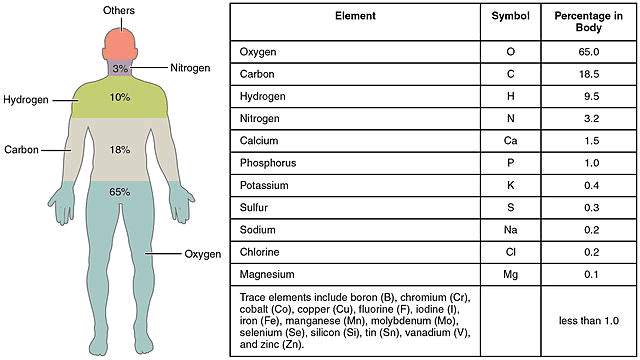Settled Science has some very strange fixations about water and mass.
A classic example of these fixations is the headline statement made by Wikipedia that the average male body is “approximately 60% water” by weight.
By weight, the average human adult male is approximately 60% water.
Unfortunately, this headline approximation is fairly meaningless quantitatively because the water content [by weight] of the human body ranges between 42% and 75%.
However, there can be considerable variation in body water percentage based on a number of factors like age, health, weight, and gender.
In a large study of adults of all ages and both sexes, the adult human body averaged ~53% water.
However, this varied substantially by age, sex, and adiposity (amount of fat in body composition).
The figure for water fraction by weight in this sample was found to be 48 ±6% for females and 58 ±8% water for males.
The body water constitutes as much as 75% of the body weight of a newborn infant, whereas some obese people are as little as 45% water by weight.
However, this headline approximation is also fairly meaningless qualitatively because the various atoms and molecules found in the human body are not of equal mass.
Wikipedia becomes slightly more relevant when it discusses the composition of the human body when it informs us that “most of the mass of the human body is oxygen, but most of the atoms in the human body are hydrogen atoms.”
The elemental composition of the human body can be looked at from the point of view of either mass composition, or atomic composition.
To illustrate both views, the adult male human body is approximately 57% water, and water is 11% hydrogen by mass but 67% hydrogen by atomic percent.
Thus, most of the mass of the human body is oxygen, but most of the atoms in the human body are hydrogen atoms.
…
Almost 99% of the mass of the human body is made up of the six elements oxygen, carbon, hydrogen, nitrogen, calcium, and phosphorus.Only about 0.85% is composed of another five elements: potassium, sulfur, sodium, chlorine, and magnesium. All are necessary to life.
The remaining elements are trace elements, of which more than a dozen are thought to be necessary for life, or play a role in good health (e.g., fluorine, which hardens dental enamel but seems to have no other function).
However, even quantifying the atomic composition of the human body is fairly meaningless qualitatively because these reactive elements are bound to other elements to form stable molecules.
Presumably, this curious charade of mainstream misdirection is undertaken so that the casual reader doesn’t realise that 99% of molecules in the human body are water.
Thankfully, Dr Gerald Pollack [University of Washington Bioengineering] is far more direct.
The presentation is well worth watching because Dr Gerald Pollack addresses a number of interesting questions:
Dr Gerald Pollack also helps us understand a number of intriguing observations:
Dr Gerald Pollack introduces the liquid crystalline Fourth Phase of Water.















Oh the mess that is mass.
Mass is the force an object experiences due to the presence of another object (both being made up of matter). An object of matter in isolation has no mass since it takes two to mass about.
I raised this conundrum in my MSc thesis decades ago and suggested that objects might be better described in terms of units of charge per unit of volume. Que?
Have 2 dimensionally identical spheres of lead and aluminium. The lead sphere has more mass and is thus heavier. simply to number of protons per unit volume and one can see that there are more protons in the lead sphere than the aluminium sphere. Hence when both these spheres are dropped from a height, both will arrive at the ground at the same time (everything else being equal).
I was mildly castigated for this intellectual novelty, which was of no consequence since I was not allowed to publish my thesis in anywise since it involved ‘secret mining company ore reserve data).
Oops, both spheres arrive at the ground level at the same time since both are comprised of protons, which are identical of course.
I would like to once again note that the amount of water in the body depends on the age of the body.
“In the process of development (aging), the living body (as it has been known for a long time) loses water and acquires lipids (fat), proteins, polysaccharides and other energy-intensive chemical compounds. If we look at this phenomenon from the viewpoint of physical chemistry, it will be obvious that the system is enriched with organic matter that is obviously less stable than water, the amount of which significantly decreases with aging”.
Have a look at please:
Georgi P. Gladyshev (2015). Natural Selection and Thermodynamics of Biological Evolution. Natural Science, 7, No 5 117-126 Published Online March 2015 Pub. Date: March 9, 2015
DOI: 10.4236/ns.2015.73013 http://dx.doi.org/10.4236/ns.2015.73013
Georgi P. Gladyshev (2015). Thermodynamics of Aging and Heredity. Natural Science, 7, No 5 270-286 Published Online May 2015 http://dx.doi.org/10.4236/ns.2015.75031
http://www.scirp.org/journal/ns
(Typo: Figure 1 (page 272) in the center of the upper part of the figure (A) in the inequality instead of “”, as in other articles and monographies (see for example [28]. – http://www.mdpi.org/ijms/papers/i7030098.pdf ).
Thanks!
Sincerely,
Georgi Gladyshev
Pingback: The Power of Positive Words – Can we change our body with words? | HealThruWords, Inspirational Quotes
Reading Pollack’s book just now—can’t recommend it enough!
Pingback: Dying of Thirst – Fast News Daily
Pingback: Alaskan Muck: Prime Suspects | MalagaBay